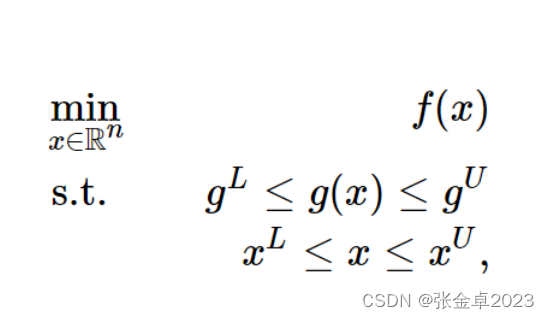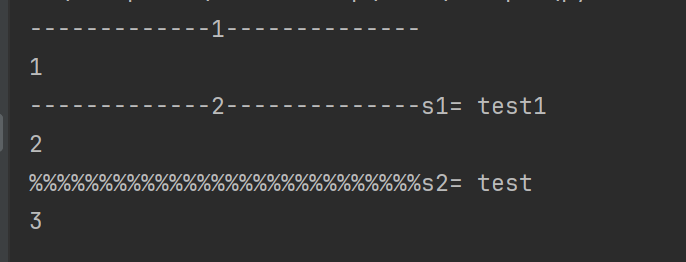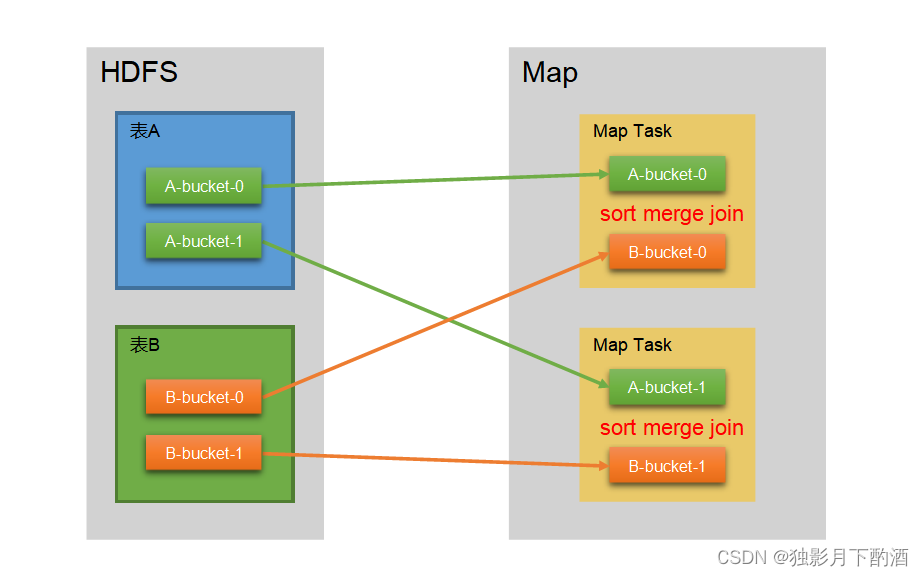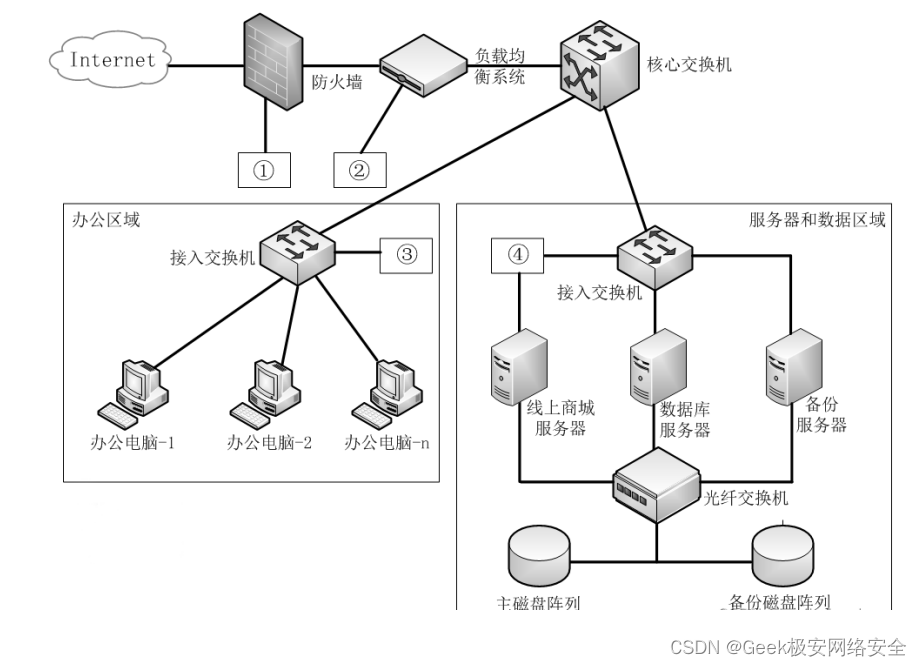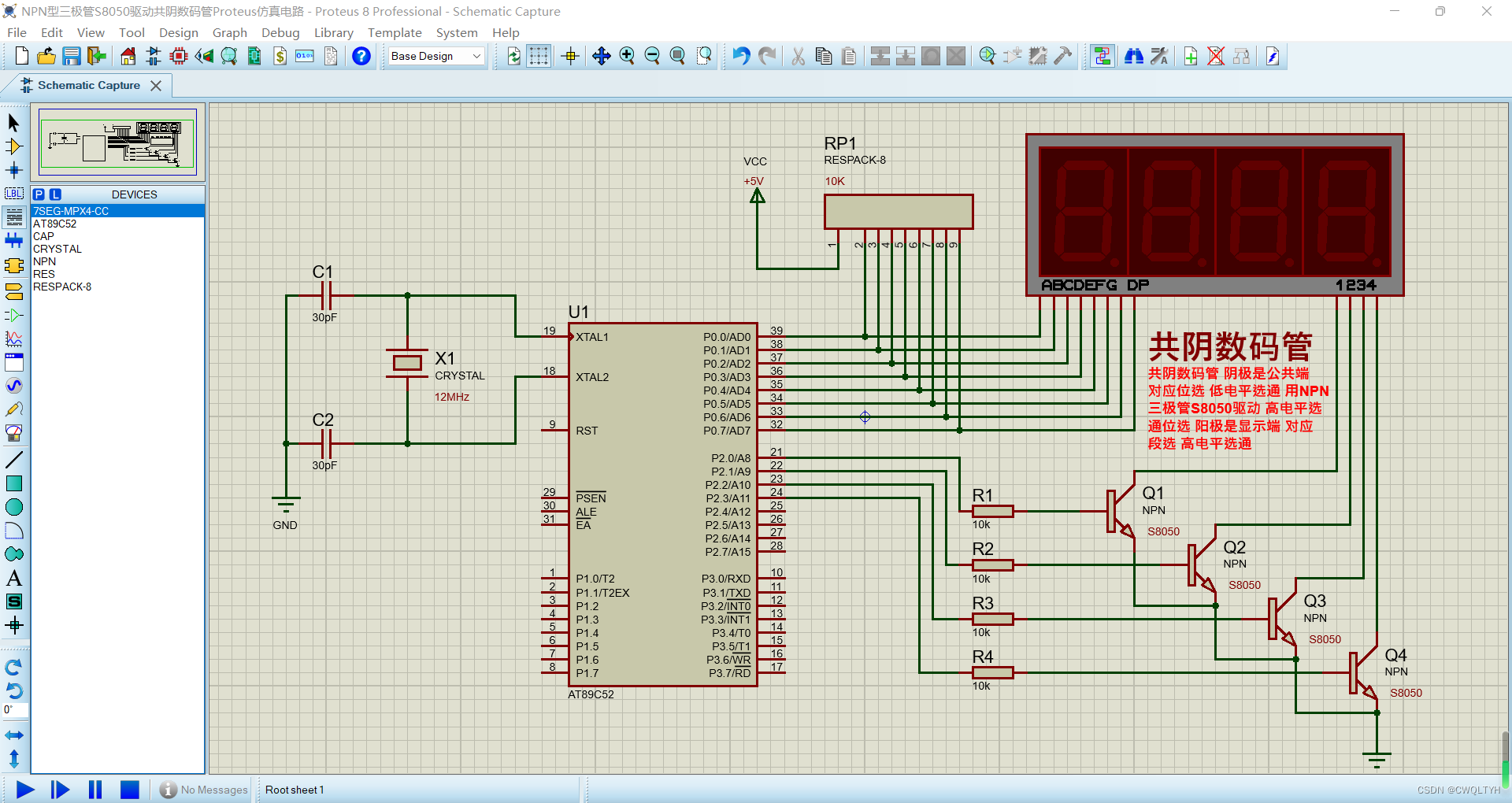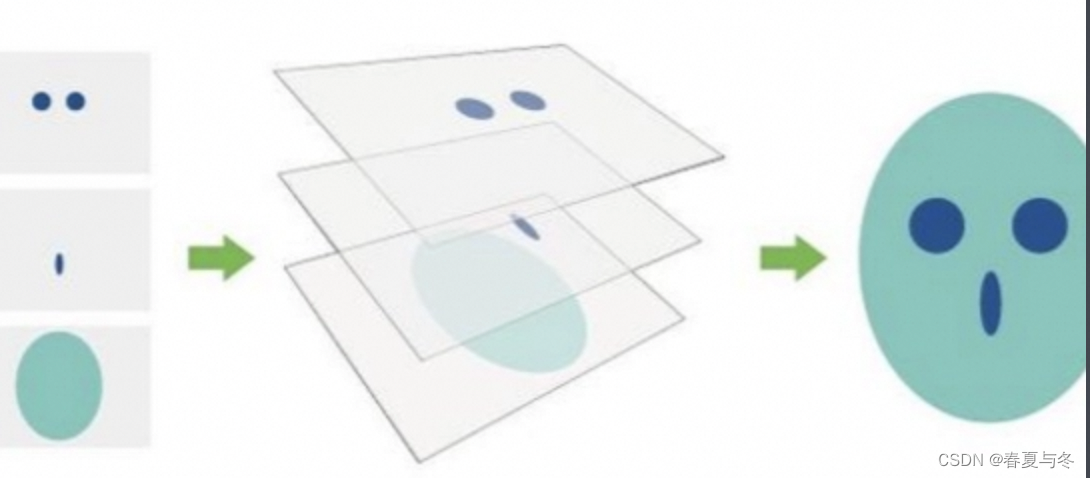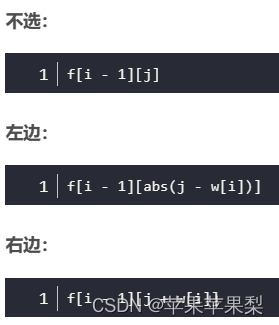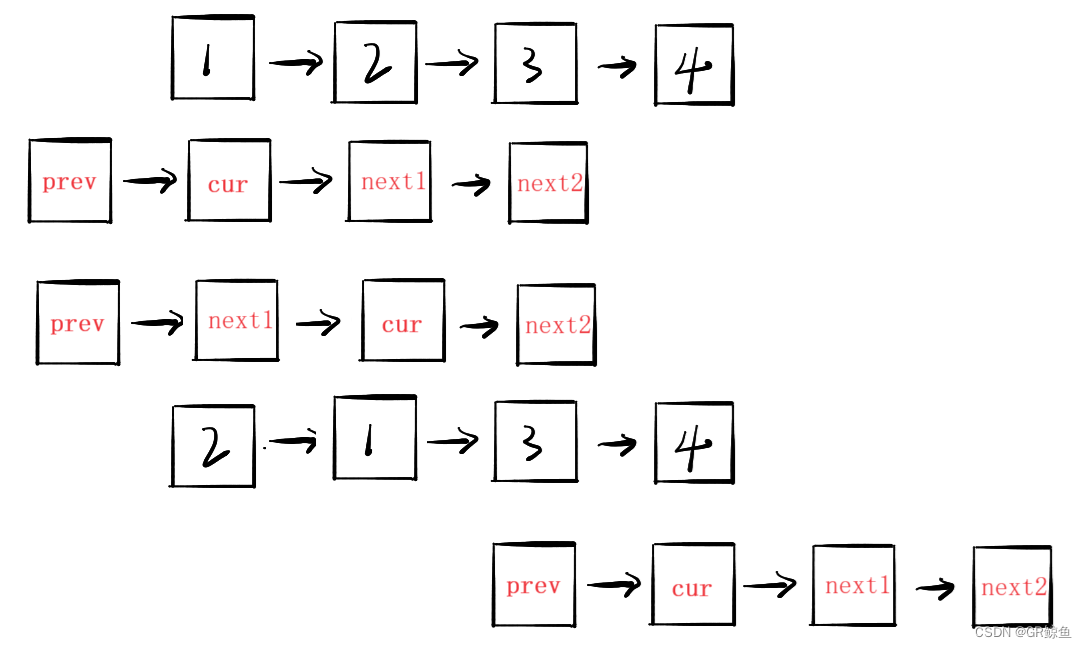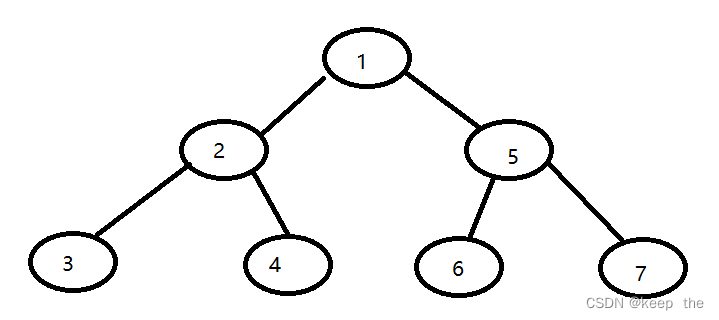在C++98中,STL提供了底层为红黑树结构的一系列关联式容器,例如map、set等。它们在搜索数据时效率可达到O(logN),但最糟糕的情况下搜索需要比较红黑树的高度次,若此时树中的节点非常之多,那么搜索效率就非常不理想。
最理想的搜索是,进行较少的比较次数就能够将元素找到。于是,在C++11中,STL又提供了4个unordered系列的关联式容器,即unordered_map 、unordered_set、unordered_multimap和unordered_multiset。这四个容器与红黑树结构的关联式容器的使用方式基本类似,但不同的是,它们的底层结构为哈希桶。
本篇博客unordered_map和unordered_set的特性和常见用法,并搭配对STL源码的模拟实现,旨在更好地帮助读者理解容器的功能。
目录
一、无序的关联式容器
1.Unordered_map
2.Unordered_set
二、同一种底层数据结构支持两种不同的容器
1.底层哈希桶的实现
2.上层的初步封装
· unordered_map
· unordered_set
3.普通迭代器
· 基本结构
· 相关功能
· 上层的进一步封装
4.const迭代器
· 基本结构
· 上层的进一步封装
5.insert() 的返回值与operator[ ]
6.键值不匹配的解决方案
7.模拟实现的完整代码
· HashTable.h
· unordered_map.h
· unordered_set.h
一、无序的关联式容器
1.Unordered_map
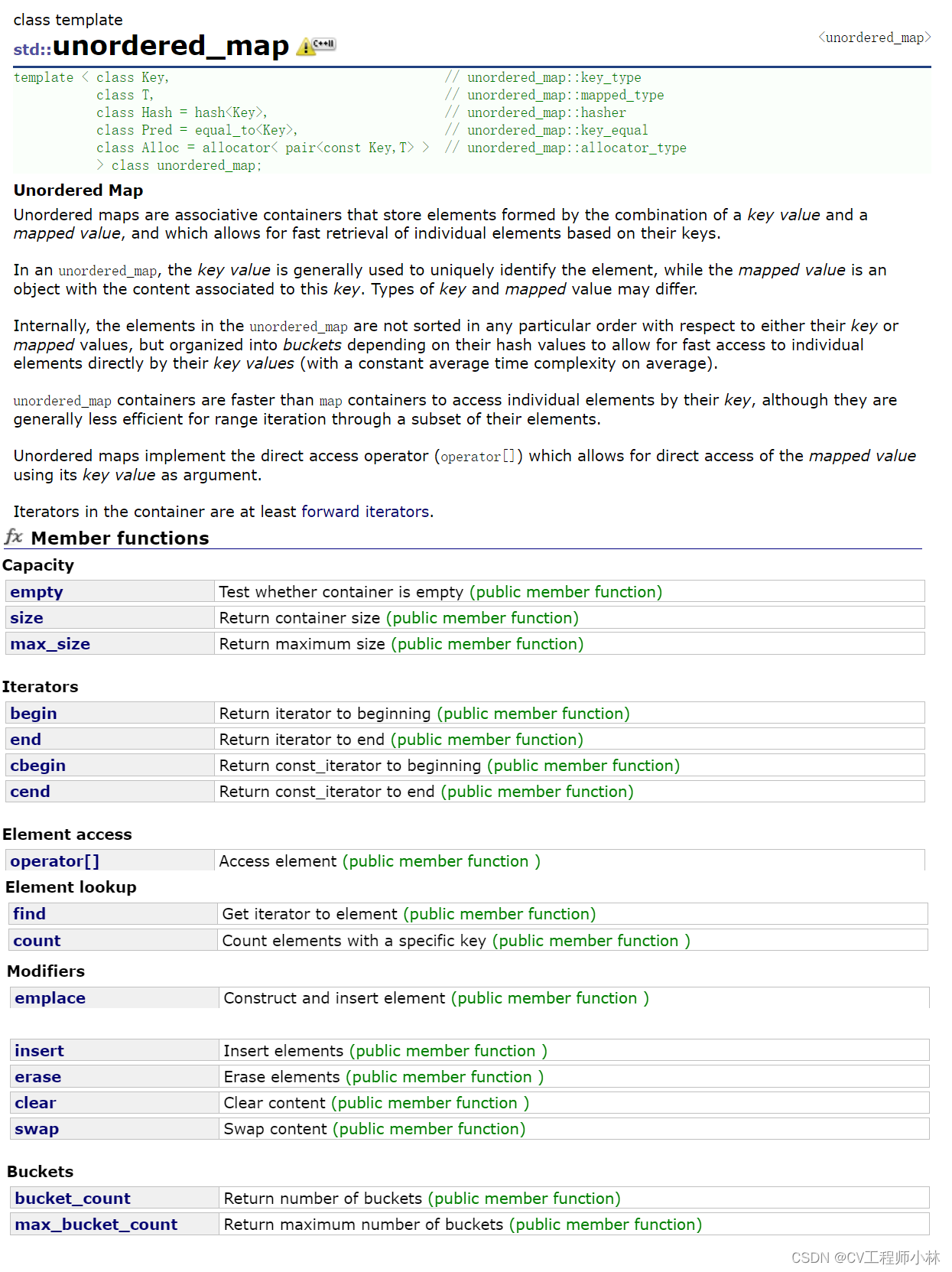
Unordered_map(无序映像)是一种存储<key,value>键值对的关联式容器,使用时需包含该容器的头文件“#include<unordered_map>”,底层为哈希桶,支持通过key快速地索引到与之对应的value(为了能在常数范围内找到key所对应的value,它将具有相同哈希地址的键值对放在相同的桶中)。
对于unordered_map中的元素,键值key通常用于惟一地标识它,实值value则表示它本身的值。键值key和实值value是一一对应的,它们的类型可以不同。它们在容器内没有对按照任何特定的顺序来排序,所以unordered_map相当于是map的”不排序但去重“版本。
Unordered_map通过key访问单个元素要比map快(这是因为其底层是哈希桶),但在遍历迭代方面效率通常较低。它支持下标访问符[ ],允许使用key作为参数直接访问value。
Unordered_map的迭代器一般为正向迭代器。
#include<unordered_map>void test_unordered_map()
{unordered_map<string, string> up; //调用默认构造定义一个空的容器unordered_map<string, string> up2(up);//调用拷贝构造创建并初始化一个容器//emplace()构造并插入元素up.emplace("1", "apple");up.emplace("2", "banana");up.emplace("3", "orange");up.emplace("4", "pear");up.emplace("5", "watermelon");//迭代器遍历for ( auto it = up.begin(); it != up.end(); ++it ){cout << " " << it->first << ":" << it->second << endl;}//insert()插入元素up2.insert ( {{"sugar",0.8},{"salt",0.1}} ); //默认构造插入pair<string,double> myshopping ("baking powder",0.3);up2.insert (myshopping); //拷贝构造插入 up2.insert (make_pair<string,double>("eggs",6.0)); //移动构造插入up2.insert (up.begin(), up.end()); //迭代器范围插入//范围for遍历容器for (auto& kv : up2){cout << kv.first << ":" << kv.second << endl;}//通过[]也可以插入元素unordered_map<string, string> dict;dict["sort"] = "排序";dict["insert"] = "插入";dict["string"] = "字符串";dict["left"];for (auto& kv : dict){cout << kv.first << ":" << kv.second << endl;}//查找auto it = dict.find(sort); if ( it == dict.end() ) {cout << "not found" << endl;}else {cout << it->first << " is " << it->second << endl;}string s="insert";if (dict.count(s)>0){cout << "dict has " << s << endl;}//删除up.erase ( up.begin() ); //迭代器指定删除up.erase ("2"); //key指定删除up.erase ( up.find("3"), up.end() ); //迭代器范围删除//验空+查大小if( up.empty() ){cout << up.size() << endl;}
}2.Unordered_set

Unordered_set(无序集合)是一种只存储键值key的关联式容器,使用时需包含该容器的头文件“#include<unordered_set>”,底层为哈希桶,支持对键值key的快速检索。
对于unordered_set中的元素,它们的实值同时也是唯一标识它的键值。键值key在设置上是不可变的,因此,容器中的元素不可修改,只可插入和删除。容器中的元素没有对按照任何特定的顺序来排序,所以unordered_set相当于是set的”不排序但去重“版本。
Unordered_set访问单个元素要比set快(这是因为其底层是哈希桶),但在遍历迭代方面效率通常较低。
Unordered_set的迭代器一般为正向迭代器。
void test_unordered_set()
{//unordered_set仅能去重unordered_set<int> us; //调用默认构造定义一个空的容器unordered_set<int> us2(us);//调用拷贝构造创建并初始化一个容器//插入us.insert(3);us.insert(1);us.insert(3);us.insert(4);us.insert(5);//迭代器遍历unordered_set<int>::iterator it = us.begin(); while (it != us.end()){cout << *it << "";//3 1 4 5 ++it;}cout << endl;//查找for (auto& x: us) {if (myset.count(x)>0) cout << "us has " << x << endl;else cout << "us has no " << x << endl;}unordered_set<int>::const_iterator got = us.find (6);if ( got == myset.end() ) cout << "not found in us";else cout << *got << " is in us";//删除us.erase ( us.begin() ); us.erase (4); us.erase (us.find(1), us.end() ); }二、同一种底层数据结构支持两种不同的容器
(这一小节在【C++】map 和 set 中有逻辑相似的、更加详细的STL源码解析)
1.底层哈希桶的实现
(关于哈希桶的更多解析详见:【数据结构】哈希)
//HashTable.h#include<vector>template<class K>
struct DefaultHashFunc
{size_t operator()(const K& key){return (size_t)key;}
};
template<>
struct DefaultHashFunc<string>
{size_t operator()(const string& str){size_t hash = 0;for (auto ch : str){hash *= 131;hash += ch;}return hash;}
};namespace hash_bucket
{template<class T>struct HashNode{T _data;HashNode<T>* _next;HashNode(const T& data):_data(data),_next(nullptr){}};template<class K, class T, class KeyOfT, class HashFunc = DefaultHashFunc<K>>class HashTable{typedef HashNode<T> Node;public:HashTable(){_table.resize(10, nullptr);}~HashTable(){for (size_t i = 0; i < _table.size(); i++){Node* cur = _table[i];while (cur){Node* next = cur->_next;delete cur;cur = next;}_table[i] = nullptr;}}bool Insert(const T& data){KeyOfT kot;if(Find(kot(data))){return false;}HashFunc hf;if (_n == _table.size()){size_t newSize = _table.size()*2;vector<Node*> newTable;newTable.resize(newSize, nullptr);for (size_t i = 0; i < _table.size(); i++){Node* cur = _table[i];while (cur){Node* next = cur->_next;size_t hashi = hf(kot(cur->_data)) % newSize;cur->_next = newTable[hashi];newTable[hashi] = cur;cur = next;}_table[i] = nullptr;}_table.swap(newTable);}size_t hashi = hf(kot(data)) % _table.size();Node* newnode = new Node(data);newnode->_next = _table[hashi];_table[hashi] = newnode;++_n;return true;}Node* Find(const K& key){HashFunc hf;KeyOfT kot;size_t hashi = hf(key) % _table.size();Node* cur = _table[hashi];while (cur){if (kot(cur->_data) == key){return cur;}cur = cur->_next;}return nullptr;}bool Erase(const K& key){HashFunc hf;KeyOfT kot;size_t hashi = hf(key) % _table.size();Node* prev = nullptr;Node* cur = _table[hashi];while (cur){if (kot(cur->_data) == key){if (prev == nullptr){_table[hashi] = cur->_next;}else{prev->_next = cur->_next;}--_n;delete cur; return true;}prev = cur;cur = cur->_next;}return false;}private:vector<Node*> _table; // 挂满链表的指针数组size_t _n = 0; // 有效数据个数};
}2.上层的初步封装
· unordered_map
//unordered_map.h#include"HashTable.h"namespace CVE
{template<class K, class V>class unordered_map{struct MapKeyOfT{const K& operator()(const pair<K, V>& kv){return kv.first;}};private:hash_bucket::HashTable<K, pair<K, V>, MapKeyOfT> _ht;};
}// unordered_map -> hash_bucket::HashTable<K, pair<K, V>> _ht;
// unordered_set -> hash_bucket::HashTable<K, K> _ht;· unordered_set
//unordered_set.h#include"HashTable.h"namespace CVE
{template<class K>class unordered_set{struct SetKeyOfT{const K& operator()(const K& key){return key;}};private:hash_bucket::HashTable<K, K, SetKeyOfT> _ht;};
}// unordered_map -> hash_bucket::HashTable<K, pair<K, V>> _ht;
// unordered_set -> hash_bucket::HashTable<K, K> _ht;3.普通迭代器
· 基本结构
//HashTable.hnamespace hash_bucket
{//哈希桶中链表节点template<class T>struct HashNode{T _data;HashNode<T>* _next;HashNode(const T& data):_data(data),_next(nullptr){}};//前置声明哈希桶//因为迭代器中要用哈希桶的指针作为成员template<class K, class T, class KeyOfT, class HashFunc>class HashTable;//普通迭代器template<class K, class T, class KeyOfT, class HashFunc>struct HTIterator{typedef HashNode<T> Node;typedef HTIterator<K, T, KeyOfT, HashFunc> Self;Node* _node; //哈希桶的当前节点HashTable<K, T, KeyOfT, HashFunc>* _pht; //哈希桶的指针//构造函数HTIterator(Node* node, HashTable<K, T, KeyOfT, HashFunc>* pht):_node(node),_pht(pht){}//...//哈希桶(哈希表)template<class K, class T, class KeyOfT, class HashFunc = DefaultHashFunc<K>>class HashTable{//...public:typedef HTIterator<K, T, KeyOfT, HashFunc> iterator;//...};}· 相关功能
//HashTable.hnamespace hash_bucket
{//...template<class K, class T, class KeyOfT, class HashFunc>struct HTIterator{typedef HashNode<T> Node;typedef HTIterator<K, T, KeyOfT, HashFunc> Self;Node* _node; //哈希桶的当前节点HashTable<K, T, KeyOfT, HashFunc>* _pht; //哈希桶的指针HTIterator(Node* node, HashTable<K, T, KeyOfT, HashFunc>* pht):_node(node),_pht(pht){}//*重载T& operator*(){return _node->_data; }//->重载T* operator->(){return &_node->_data;}//++重载Self& operator++(){//_node是某一个桶中的当前节点的指针// 当前桶中链表还没完,就遍历到下一个链表节点if (_node->_next){_node = _node->_next;}// 当前桶中链表走完了,就去找下一个挂了链表的桶(即不为空的桶)else{// 取当前桶的哈希地址KeyOfT kot;HashFunc hf;size_t hashi = hf(kot(_node->_data)) % _pht->_table.size();// 去下一个相邻的哈希地址查找下一个不为空的桶++hashi;while (hashi < _pht->_table.size()){//找到了,将_node(当前节点的指针)置为找到的桶的指针,并返回if (_pht->_table[hashi]){_node = _pht->_table[hashi];return *this;}//没找到就再去下一个相邻的哈希地址找else{++hashi; }}_node = nullptr;}//遍历到桶中的下一个节点,或哈希表遍历完了,都返回当前节点(的指针)return *this;}//!=重载bool operator!=(const Self& s){return _node != s._node;}};template<class K, class T, class KeyOfT, class HashFunc = DefaultHashFunc<K>>class HashTable{typedef HashNode<T> Node;// 友元声明// 否则HTIterator的对象无法访问HashTable的私有成员template<class K, class T, class KeyOfT, class HashFunc>friend struct HTIterator;public:typedef HTIterator<K, T, KeyOfT, HashFunc> iterator;iterator begin(){// 找第一个桶for (size_t i = 0; i < _table.size(); i++){Node* cur = _table[i];if (cur){return iterator(cur, this);}}return iterator(nullptr, this);}iterator end(){return iterator(nullptr, this);}//...}}· 上层的进一步封装
· unordered_map
//unordered_map.h#include"HashTable.h"namespace CVE
{template<class K, class V>class unordered_map{struct MapKeyOfT{const K& operator()(const pair<K, V>& kv){return kv.first;}};public:typedef typename hash_bucket::HashTable<K, pair<K, V>, MapKeyOfT>::iterator iterator;iterator begin(){return _ht.begin();}iterator end(){return _ht.end();}private:hash_bucket::HashTable<K, pair<K, V>, MapKeyOfT> _ht;};
}
· unordered_set
//unordered_set.h#include"HashTable.h"namespace CVE
{template<class K>class unordered_set{struct SetKeyOfT{const K& operator()(const K& key){return key;}};public:typedef typename hash_bucket::HashTable<K, K, SetKeyOfT>::iterator iterator;iterator begin(){return _ht.begin();}iterator end(){return _ht.end();}private:hash_bucket::HashTable<K, K, SetKeyOfT> _ht;};
}4.const迭代器
· 基本结构
namespace hash_bucket
{template<class T>struct HashNode{T _data;HashNode<T>* _next;HashNode(const T& data):_data(data),_next(nullptr){}};template<class K, class T, class KeyOfT, class HashFunc>class HashTable;template<class K, class T, class Ptr, class Ref, class KeyOfT, class HashFunc>struct HTIterator{typedef HashNode<T> Node;typedef HTIterator<K, T, Ptr, Ref, KeyOfT, HashFunc> Self;typedef HTIterator<K, T, T*, T&, KeyOfT, HashFunc> Iterator;Node* _node;const HashTable<K, T, KeyOfT, HashFunc>* _pht;HTIterator(Node* node, const HashTable<K, T, KeyOfT, HashFunc>* pht):_node(node), _pht(pht){}// 对于普通迭代器对象,这是拷贝构造// 对于const迭代器对象,这是构造,同时也支持普通迭代器去构造const迭代器HTIterator(const Iterator& it):_node(it._node), _pht(it._pht){}Ref operator*(){return _node->_data;}Ptr operator->(){return &_node->_data;}Self& operator++(){if (_node->_next){_node = _node->_next;}else{KeyOfT kot;HashFunc hf;size_t hashi = hf(kot(_node->_data)) % _pht->_table.size();++hashi;while (hashi < _pht->_table.size()){if (_pht->_table[hashi]){_node = _pht->_table[hashi];return *this;}else{++hashi;}}_node = nullptr;}return *this;}bool operator!=(const Self& s){return _node != s._node;}bool operator==(const Self& s){return _node == s._node;}};template<class K, class T, class KeyOfT, class HashFunc = DefaultHashFunc<K>>class HashTable{typedef HashNode<T> Node;// 友元声明template<class K, class T, class Ptr, class Ref, class KeyOfT, class HashFunc>friend struct HTIterator;public:typedef HTIterator<K, T, T*, T&, KeyOfT, HashFunc> iterator;typedef HTIterator<K, T, const T*, const T&, KeyOfT, HashFunc> const_iterator;iterator begin(){for (size_t i = 0; i < _table.size(); i++){Node* cur = _table[i];if (cur){return iterator(cur, this);}}return iterator(nullptr, this);}iterator end(){return iterator(nullptr, this);}const_iterator begin() const{for (size_t i = 0; i < _table.size(); i++){Node* cur = _table[i];if (cur){return const_iterator(cur, this);}}return const_iterator(nullptr, this);}const_iterator end() const{return const_iterator(nullptr, this);}//...private:vector<Node*> _table; size_t _n = 0; };
}· 上层的进一步封装
· unordered_map
#include"HashTable.h"namespace CVE
{template<class K, class V>class unordered_map{struct MapKeyOfT{const K& operator()(const pair<const K, V>& kv){return kv.first;}};public:typedef typename hash_bucket::HashTable<K, pair<const K, V>, MapKeyOfT>::iterator iterator;typedef typename hash_bucket::HashTable<K, pair<const K, V>, MapKeyOfT>::const_iterator const_iterator;iterator begin(){return _ht.begin();}iterator end(){return _ht.end();}const_iterator begin() const{return _ht.begin();}const_iterator end() const{return _ht.end();}//...private:hash_bucket::HashTable<K, pair<const K, V>, MapKeyOfT> _ht;};
}
· unordered_set
#pragma once#include"HashTable.h"namespace CVE
{template<class K>class unordered_set{struct SetKeyOfT{const K& operator()(const K& key){return key;}};public:typedef typename hash_bucket::HashTable<K, K, SetKeyOfT>::const_iterator iterator;typedef typename hash_bucket::HashTable<K, K, SetKeyOfT>::const_iterator const_iterator;const_iterator begin() const{return _ht.begin();}const_iterator end() const{return _ht.end();}//...private:hash_bucket::HashTable<K, K, SetKeyOfT> _ht;};
}
5.insert() 的返回值与operator[ ]
//HashTable.hnamespace hash_bucket
{//...template<class K, class T, class KeyOfT, class HashFunc = DefaultHashFunc<K>>class HashTable{typedef HashNode<T> Node;template<class K, class T, class Ptr, class Ref, class KeyOfT, class HashFunc>friend struct HTIterator;public:typedef HTIterator<K, T, T*, T&, KeyOfT, HashFunc> iterator;typedef HTIterator<K, T, const T*, const T&, KeyOfT, HashFunc> const_iterator;//...pair<iterator, bool> Insert(const T& data){KeyOfT kot;iterator it = Find(kot(data));if(it != end()){return make_pair(it, false);}HashFunc hf;if (_n == _table.size()){//size_t newSize = _table.size() * 2;size_t newSize = GetNextPrime(_table.size());vector<Node*> newTable;newTable.resize(newSize, nullptr);for (size_t i = 0; i < _table.size(); i++){Node* cur = _table[i];while (cur){Node* next = cur->_next;size_t hashi = hf(kot(cur->_data)) % newSize;cur->_next = newTable[hashi];newTable[hashi] = cur;cur = next;}_table[i] = nullptr;}_table.swap(newTable);}size_t hashi = hf(kot(data)) % _table.size();Node* newnode = new Node(data);newnode->_next = _table[hashi];_table[hashi] = newnode;++_n;return make_pair(iterator(newnode, this), true);}iterator Find(const K& key){HashFunc hf;KeyOfT kot;size_t hashi = hf(key) % _table.size();Node* cur = _table[hashi];while (cur){if (kot(cur->_data) == key){return iterator(cur, this);}cur = cur->_next;}return end();}//...private:vector<Node*> _table; size_t _n = 0; };
}//unordered_map.h#include"HashTable.h"namespace CVE
{template<class K, class V>class unordered_map{struct MapKeyOfT{const K& operator()(const pair<const K, V>& kv){return kv.first;}};public:typedef typename hash_bucket::HashTable<K, pair<const K, V>, MapKeyOfT>::iterator iterator;typedef typename hash_bucket::HashTable<K, pair<const K, V>, MapKeyOfT>::const_iterator const_iterator;iterator begin(){return _ht.begin();}iterator end(){return _ht.end();}const_iterator begin() const{return _ht.begin();}const_iterator end() const{return _ht.end();}pair<iterator, bool> insert(const pair<K, V>& kv){return _ht.Insert(kv);}V& operator[](const K& key){pair<iterator, bool> ret = _ht.Insert(make_pair(key, V()));return ret.first->second;}private:hash_bucket::HashTable<K, pair<const K, V>, MapKeyOfT> _ht;};
}
6.键值不匹配的解决方案
//unordered_set.h#include"HashTable.h"namespace CVE
{template<class K>class unordered_set{struct SetKeyOfT{const K& operator()(const K& key){return key;}};public:typedef typename hash_bucket::HashTable<K, K, SetKeyOfT>::const_iterator iterator;typedef typename hash_bucket::HashTable<K, K, SetKeyOfT>::const_iterator const_iterator;const_iterator begin() const{return _ht.begin();}const_iterator end() const{return _ht.end();}pair<const_iterator, bool> insert(const K& key){pair<typename hash_bucket::HashTable<K, K, SetKeyOfT>::iterator, bool> ret = _ht.Insert(key);//先用一个<普通迭代器,布尔值>的对象接收插入方法的返回值return pair<const_iterator, bool>(ret.first, ret.second);//再将对象中的普通迭代器通过构造函数构造为const迭代器}private:hash_bucket::HashTable<K, K, SetKeyOfT> _ht;};
}
7.模拟实现的完整代码
· HashTable.h
#include<vector>template<class K>
struct DefaultHashFunc
{size_t operator()(const K& key){return (size_t)key;}
};
template<>
struct DefaultHashFunc<string>
{size_t operator()(const string& str){size_t hash = 0;for (auto ch : str){hash *= 131;hash += ch;}return hash;}
};namespace hash_bucket
{template<class T>struct HashNode{T _data;HashNode<T>* _next;HashNode(const T& data):_data(data),_next(nullptr){}};template<class K, class T, class KeyOfT, class HashFunc>class HashTable;template<class K, class T, class Ptr, class Ref, class KeyOfT, class HashFunc>struct HTIterator{typedef HashNode<T> Node;typedef HTIterator<K, T, Ptr, Ref, KeyOfT, HashFunc> Self;typedef HTIterator<K, T, T*, T&, KeyOfT, HashFunc> Iterator;Node* _node;const HashTable<K, T, KeyOfT, HashFunc>* _pht;HTIterator(Node* node, const HashTable<K, T, KeyOfT, HashFunc>* pht):_node(node), _pht(pht){}HTIterator(const Iterator& it):_node(it._node), _pht(it._pht){}Ref operator*(){return _node->_data;}Ptr operator->(){return &_node->_data;}Self& operator++(){if (_node->_next){_node = _node->_next;}else{KeyOfT kot;HashFunc hf;size_t hashi = hf(kot(_node->_data)) % _pht->_table.size();++hashi;while (hashi < _pht->_table.size()){if (_pht->_table[hashi]){_node = _pht->_table[hashi];return *this;}else{++hashi;}}_node = nullptr;}return *this;}bool operator!=(const Self& s){return _node != s._node;}bool operator==(const Self& s){return _node == s._node;}};template<class K, class T, class KeyOfT, class HashFunc = DefaultHashFunc<K>>class HashTable{typedef HashNode<T> Node;template<class K, class T, class Ptr, class Ref, class KeyOfT, class HashFunc>friend struct HTIterator;public:typedef HTIterator<K, T, T*, T&, KeyOfT, HashFunc> iterator;typedef HTIterator<K, T, const T*, const T&, KeyOfT, HashFunc> const_iterator;iterator begin(){for (size_t i = 0; i < _table.size(); i++){Node* cur = _table[i];if (cur){return iterator(cur, this);}}return iterator(nullptr, this);}iterator end(){return iterator(nullptr, this);}const_iterator begin() const{for (size_t i = 0; i < _table.size(); i++){Node* cur = _table[i];if (cur){return const_iterator(cur, this);}}return const_iterator(nullptr, this);}const_iterator end() const{return const_iterator(nullptr, this);}//每次快速取模的是一个类似两倍关系的素数,可以更好地支持除留余数法寻址和扩容//但这个方法并没有明确的理论依据//C++的STL库中用了这样的方法,而Java库中没有用size_t GetNextPrime(size_t prime){static const int __stl_num_primes = 28;static const unsigned long __stl_prime_list[__stl_num_primes] ={53, 97, 193, 389, 769,1543, 3079, 6151, 12289, 24593,49157, 98317, 196613, 393241, 786433,1572869, 3145739, 6291469, 12582917, 25165843,50331653, 100663319, 201326611, 402653189, 805306457,1610612741, 3221225473, 4294967291};size_t i = 0;for (; i < PRIMECOUNT; ++i){if (primeList[i] > prime)return primeList[i];}return primeList[i];}HashTable(){_table.resize(GetNextPrime(1), nullptr);}~HashTable(){for (size_t i = 0; i < _table.size(); i++){Node* cur = _table[i];while (cur){Node* next = cur->_next;delete cur;cur = next;}_table[i] = nullptr;}}pair<iterator, bool> Insert(const T& data){KeyOfT kot;iterator it = Find(kot(data));if(it != end()){return make_pair(it, false);}HashFunc hf;if (_n == _table.size()){size_t newSize = GetNextPrime(_table.size());vector<Node*> newTable;newTable.resize(newSize, nullptr);for (size_t i = 0; i < _table.size(); i++){Node* cur = _table[i];while (cur){Node* next = cur->_next;size_t hashi = hf(kot(cur->_data)) % newSize;cur->_next = newTable[hashi];newTable[hashi] = cur;cur = next;}_table[i] = nullptr;}_table.swap(newTable);}size_t hashi = hf(kot(data)) % _table.size();Node* newnode = new Node(data);newnode->_next = _table[hashi];_table[hashi] = newnode;++_n;return make_pair(iterator(newnode, this), true);}iterator Find(const K& key){HashFunc hf;KeyOfT kot;size_t hashi = hf(key) % _table.size();Node* cur = _table[hashi];while (cur){if (kot(cur->_data) == key){return iterator(cur, this);}cur = cur->_next;}return end();}bool Erase(const K& key){HashFunc hf;KeyOfT kot;size_t hashi = hf(key) % _table.size();Node* prev = nullptr;Node* cur = _table[hashi];while (cur){if (kot(cur->_data) == key){if (prev == nullptr){_table[hashi] = cur->_next;}else{prev->_next = cur->_next;}--_n;delete cur; return true;}prev = cur;cur = cur->_next;}return false;}private:vector<Node*> _table; size_t _n = 0; };
}· unordered_map.h
#include"HashTable.h"namespace CVE
{template<class K, class V>class unordered_map{struct MapKeyOfT{const K& operator()(const pair<const K, V>& kv){return kv.first;}};public:typedef typename hash_bucket::HashTable<K, pair<const K, V>, MapKeyOfT>::iterator iterator;typedef typename hash_bucket::HashTable<K, pair<const K, V>, MapKeyOfT>::const_iterator const_iterator;iterator begin(){return _ht.begin();}iterator end(){return _ht.end();}const_iterator begin() const{return _ht.begin();}const_iterator end() const{return _ht.end();}pair<iterator, bool> insert(const pair<K, V>& kv){return _ht.Insert(kv);}V& operator[](const K& key){pair<iterator, bool> ret = _ht.Insert(make_pair(key, V()));return ret.first->second;}private:hash_bucket::HashTable<K, pair<const K, V>, MapKeyOfT> _ht;};
}
· unordered_set.h
#include"HashTable.h"namespace CVE
{template<class K>class unordered_set{struct SetKeyOfT{const K& operator()(const K& key){return key;}};public:typedef typename hash_bucket::HashTable<K, K, SetKeyOfT>::const_iterator iterator;typedef typename hash_bucket::HashTable<K, K, SetKeyOfT>::const_iterator const_iterator;const_iterator begin() const{return _ht.begin();}const_iterator end() const{return _ht.end();}pair<const_iterator, bool> insert(const K& key){pair<typename hash_bucket::HashTable<K, K, SetKeyOfT>::iterator, bool> ret = _ht.Insert(key);return pair<const_iterator, bool>(ret.first, ret.second);}private:hash_bucket::HashTable<K, K, SetKeyOfT> _ht;};
}
